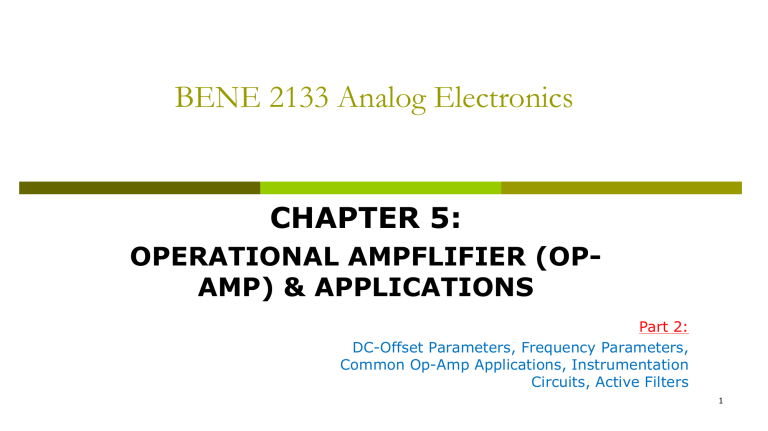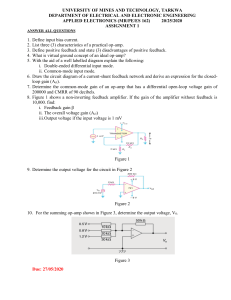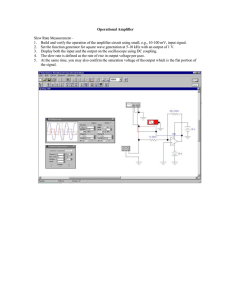
BENE 2133 Analog Electronics CHAPTER 5: OPERATIONAL AMPFLIFIER (OPAMP) & APPLICATIONS Part 2: DC-Offset Parameters, Frequency Parameters, Common Op-Amp Applications, Instrumentation Circuits, Active Filters 1 Learning Outcomes • Learn the basics of an operational amplifier • Develop an understanding of what common mode operation is • Describe double-ended input operation • Learn about constant gain, summing, and buffering amplifiers • Understand how an active filter works • Describe different types of controlled sources DC-Offset Parameters Even when the input voltage is zero, an op-amp can have an output offset. The following can cause this offset: Input offset voltage Input offset current Input offset voltage and input offset current Input bias current Input Offset Voltage (VIO) The specification sheet for an op-amp indicates an input offset voltage (VIO). The effect of this input offset voltage on the output can be calculated with Vo(offset) = VIO R1 + Rf R1 Input Offset Current (IIO) If there is a difference between the dc bias currents generated by the same applied input, this also causes an output offset voltage: The input offset current (IIO) is specified in the specifications for an op-amp. The effect of IIO on the output offset voltage can be calculated using: V o( offset ) = Vo ( offset due to VIO ) + Vo ( offset due to IIO ) Total Offset Due to VIO and IIO Op-amps may have an output offset voltage due to VIO and IIO. The total output offset voltage equals the sum of the effects of both: Vo (offset ) = Vo (offset due to VIO ) + Vo (offset due to I IO ) Input Bias Current (IIB) A parameter that is related to input offset current (IIO) is called input bias current (IIB) The input bias currents are calculated using: IIB− = I IB − IIO 2 IIB+ = IIB + The total input bias current is the average of the two: IIB− + IIB+ IIB = 2 IIO 2 Frequency Parameters An op-amp is a wide-bandwidth amplifier. The following factors affect the bandwidth of the opamp: Gain Slew rate Gain and Bandwidth The op-amp’s high frequency response is limited by its internal circuitry. The plot shown is for an open loop gain (AOL or AVD). This means that the op-amp is operating at the highest possible gain with no feedback resistor. In fact, the unity-gain frequency and cutoff frequency are related by In the open loop mode, an op-amp has a narrow bandwidth. The bandwidth widens in closed-loop mode, but the gain is lower. Example Gain and Bandwidth Slew Rate (SR) Slew rate (SR): The maximum rate at which an op-amp can change output without distortion. ΔVo SR = Δt (in V/s) The SR rating is listed in the specification sheets as the V/s rating. Example Slew Rate • For an op-amp having a slew rate of SR = 2 V/s, what is the maximum closed-loop voltage gain that can be used when the input signal varies by 0.5 V in 10 s? ΔVo SR = (in V/s) Solution: Δt VO = ACLVi VO Vi = ACL t t ACL VO / t 2 V / s SR = = = = 40 Vi / t Vi / t 0.5V / 10s Maximum Signal Frequency The slew rate determines the highest frequency of the op-amp without distortion. f SR 2πVp where VP is the peak voltage General Op-Amp Specifications Other op-amp ratings found on specification sheets are: Absolute Ratings Electrical Characteristics Performance Absolute Ratings These are common maximum ratings for the op-amp. Electrical Characteristics Note: These ratings are for specific circuit conditions, and they often include minimum, maximum and typical values. CMRR One rating that is unique to op-amps is CMRR or common-mode rejection ratio. Because the op-amp has two inputs that are opposite in phase (inverting input and the non-inverting input) any signal that is common to both inputs will be cancelled. Op-amp CMRR is a measure of the ability to cancel out commonmode signals. Op-Amp Performance The specification sheets will also include graphs that indicate the performance of the opamp over a wide range of conditions. Common Op-Amp Applications Constant-gain amplifier Voltage summing Voltage buffer Controlled sources Instrumentation circuits Active filters Constant-gain Amplifier Inverting amplifier Noninverting amplifier Multiple-Stage Gains The total gain (3-stages) is given by: or: Rf Rf Rf − − A = 1 + R1 R2 R3 A = A1A2 A3 Solution: Design each stage of Op-Amp LM124 Pin Layout Therefore, the output voltage is 11 Gain +ve Non-Inverting Op-Amp Gain -ve Non-Inverting Op-Amp Gain -ve Non-Inverting Op-Amp Voltage Summing The output is the sum of individual signals times the gain: R R R Vo = − f V1 + f V2 + f V3 R2 R3 R1 Voltage Buffer Any amplifier with no gain or loss is called a unity gain amplifier. The advantages of using a unity gain amplifier: • Very high input impedance • Very low output impedance The unity gain amplifier shown is commonly referred to as a voltage buffer or a voltage follower. Controlled Sources • Operational amplifiers can be used to form various types of controlled sources. • An input voltage can be used to control an output voltage or current, or an input current can be used to control an output voltage or current. • These types of connections are suitable for use in various instrumentation circuits. • A form of each type of controlled source is provided next. Voltage-controlled voltage source Voltage-controlled current source Current-controlled voltage source Current-controlled current source Voltage-Controlled Voltage Source Noninverting Amplifier Version • non-inverting Op-Amp R VO = 1 + f V1 = kV1 R1 Inverting Amplifier Version • Inverting Op-Amp VO = − Rf R1 V1 = kV1 Voltage-Controlled Current Source The output current is: Io = V1 = kV1 R1 Current-Controlled Voltage Source This is simply another way of applying the op-amp operation. Whether the input is a current determined by Vin/R1 or as I1: Vout or − Rf = Vin R1 Vout = −I1RL Current-Controlled Current Source This circuit may appear more complicated than the others but it is really the same thing. R Vout = − f Vin Rin Vout V = − in Rf R1||R 2 Vout V = − in Rf Rin Io = − Vin R1||R 2 R + R2 Io = −Vin 1 R R 2 1 V R + R2 Io = − in 1 R1 R2 R Io = −I 1 + 1 = kI R2 Instrumentation Circuits Some examples of instrumentation circuits using op-amps: Display driver Instrumentation amplifier Display Driver When the noninverting input to the circuit in Fig. 11.27 a goes above the inverting input, the output at terminal 1 goes to the positive saturation level (near 5 V in this example) and the lamp is driven “on” when transistor Q 1 conducts. As shown in the circuit, the output of the op-amp provides 30 mA of current to the base of transistor Q 1 , which then drives 600 mA through a suitably selected transistor (with 𝛽 > 20) capable of handling that amount of current. Figure 11.27 b shows an op-amp circuit that can supply 20 mA to drive an LED display when the noninverting input goes positive compared to the inverting input. Instrumentation Amplifier For all resistors at the same value (except Rp): 2R (V1 − V2 ) = k (V1 − V2 ) Vo = 1 + RP Active Filters • Adding capacitors to op-amp circuits provides external control of the cutoff frequencies. The op-amp active filter has controllable cutoff frequencies and controllable gain. Low-pass filter High-pass filter Bandpass filter Low-Pass Filter, First-Order The upper cutoff frequency and voltage gain are given by: fOH = 1 2πR1C1 Av = 1 + Rf R1 Low-Pass Filter, Second-Order The roll-off can be made steeper by adding more RC networks. High-Pass Filter The cutoff frequency is determined by: fOL = 1 2πR1C1 Bandpass Filter There are two cutoff frequencies: upper and lower. They can be calculated using the same low-pass cutoff and highpass cutoff frequency formulas in the appropriate sections.





